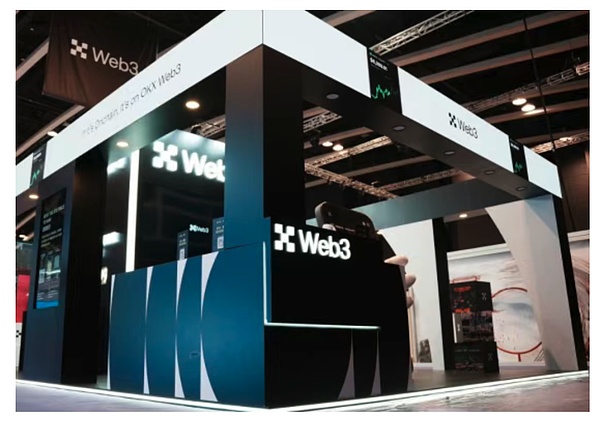Written by: Luozhou Finance
Another year of carnival, but the conference has already deteriorated.
From April 6 to April 9, the "2025 Hong Kong Web3 Carnival" hosted by Wanxiang Blockchain Laboratory and HashKey Group was held at the Hong Kong Convention and Exhibition Centre. This is the third carnival since the declaration was issued in 2022. According to the conference press release, this four-day industry event gathered nearly 400 top experts and industry leaders from global technology, finance, security, and entertainment fields. With government support and high specifications, the exhibition area increased by 50% compared to last year. However, from the on-site perspective, except for a slight increase on the third day, the overall conference seemed to lack popularity.
According to multiple attendees, the overall foot traffic was almost halved compared to previous years, with fewer than 100 booths, a significant reduction from over 150 last year and far behind the 300 booths at last year's Singapore Token2049. Some even joked about inviting elderly locals to boost attendance, dubbing it "the coldest conference ever". The reasons are multifaceted: first, the conference coincided with a tariff war with poor market performance and a bear market nature reducing participation enthusiasm; second, the Consensus conference in February somewhat preempted the event, with many previous KOLs not returning to Hong Kong; third, the lack of highlights and innovation, with participants more focused on prices than technology, making attendance merely a social gathering.
Booths symbolize strength, and booth popularity reflects concentrated attention. Among this year's conference booths, OKX undoubtedly had the largest and most popular booth, with exchanges remaining the primary sponsors. Following OKX was GMGN in the MEME category. In terms of hot topics, Payfi remained the focus, with traditional funds making significant strides. The roundtable discussions featured HSBC and ZAbank discussing Web3 payments, while the Shanghai Data Exchange and Bosera Fund also had booths. The former focused on RWA, while the latter was closely related to current digital currency funds, possibly inspired by Huaxia Fund's (Hong Kong) "Huaxia Hong Kong Dollar Digital Currency Fund".

Interestingly, besides Payfi and MEME, previously popular concepts seemed quiet in the main venue. The DePin track was neglected, with only a mechanical dog related to AI concepts. Solana and Sui, which were highly popular at the Consensus conference, had low exposure in the main venue, possibly due to low token prices. TON, after experiencing founder controversies, no longer claimed to be on the "eve of explosion", returning to the exhibition area with reduced popularity. This aligns with reality, with rumors of multiple game projects abandoning TON. The BTC ecosystem was completely ignored, with BTCFi achieving nothing, seemingly becoming a "false proposition" in the market.
From the participants' perspective, KOLs became the primary attendees, with some netizens joking that the Hong Kong conference was a "KOL talent market". In contrast, VCs retreated to the background, reminiscent of their absence at the Hong Kong Consensus conference and their previous high-profile stance, reflecting rapid changes in the industry ecosystem.
While the main venue lacked popularity, side events were bustling. Among over 100 side events, besides technical forums and hackathons, various yacht parties and events were organized by Binance, OKX, and Bitget to attract crowds. After socializing, WeChat connections were made, with many engaging in resource exchanges and discussions about wealth and rumors. Consistent with previous years, Chinese participants remained the core group, with a further decrease in overseas attendees.
The most discussed topic was the gathering of Chinese industry leaders.
At the BUIDL 2025 event, CZ, Justin Sun, and Li Lin - ancient Chinese OGs - gathered together, showcasing a rare "reconciliation". These individuals, who had various conflicts, were seen together. Two months ago, Justin Sun accused Li Lin of concealing due diligence materials, engaging in a public dispute about Huobi's $30 million financial hole. Two months later, photos of them toasting became viral. CZ and Justin Sun, as founders of Binance and TRON, also maintained a subtle competitive relationship. Just days ago, Justin Sun complained about First Digital Trust's insolvency, bringing CZ and He Yi back into the spotlight. Regardless, their friendly interactions and warm embraces were surprising, with other veterans like Shen Bo, Cai Wensheng, and Master Bao also present, leaving the market speculating about their collective return.

Unlike the popular Chinese leaders, Vitalik represented a completely opposite state. With ETH dropping below $1,500 and token prices in dire straits, Vitalik received only criticism and blame. A magical scene unfolded where Vitalik confidently spoke about building Ethereum as a world computer, while the audience collectively complained about token prices. The conflict between technical and price-focused participants was evident. Interestingly, some industry insiders on X noted that CZ was more popular than Vitalik when they appeared simultaneously. The crowd's flow followed liquidity, indirectly reflecting shifting beliefs. Perhaps compared to Vitalik, the more "internet celebrity-like" CZ currently has greater crowd influence. After all, in the on-site price predictions, $800 had become a common expectation for ETH, while BNB still had shilling potential.
Overall, from the high spirits of 2023 to the crowded scene of 2024 and now the cooling atmosphere, Hong Kong has witnessed BTC's journey from $17,000 to $100,000 and then falling back to $82,000, experiencing the entire process from bear market to bull market and the intersection of both. The conference perfectly reflects the industry's current state. The lack of hot spots and innovation, and the absence of real applications seem to have been deliberately overlooked. The bear market has initially taken shape, with exchanges anxiously attracting new users, project teams lamenting, retail investors stubbornly holding onto Altcoins, and VC's bullets nearly exhausted. However, the bear market is not without advantages - less noise, lower costs, and a crucial period for product refinement, which is conducive to the emergence of good projects. On the other hand, the circulation of new assets and money flow are key, with traditional and emerging sectors converging, and regulations continuously improving, presenting both opportunities and challenges. But returning to the conference itself, gossip flying everywhere and social interactions taking center stage still represent the current situation, with mysteries like Justin Sun's girlfriend and viral "egg literature" spreading, and the bustling crowd with diverse thoughts, with mismatches seemingly reflecting the industry's development.
Turning to Hong Kong, although Web3 development has not been entirely satisfactory for various reasons, the ecosystem has initially taken shape. From a policy perspective, whether it's RWA pilot programs or stablecoin regulation, Hong Kong remains at the forefront of Web3 openness globally. At the conference, Financial Secretary Christopher Hui stated that the Financial Services and the Treasury Bureau and the Hong Kong Monetary Authority are developing regulatory frameworks for stablecoin issuers in Hong Kong. The second policy statement on virtual asset development will be published this year. To date, the government has allocated 50 million Hong Kong dollars to support Cyberport in building the Web3 ecosystem, attracting numerous Web3 enterprises to settle in Hong Kong.
According to Financial Secretary Christopher Hui, as of September last year, Hong Kong had over 1,100 fintech enterprises, with an annual growth of over 15%, covering diverse fields including digital banks, virtual insurance, and virtual asset education platforms, including 8 licensed digital banks, 4 licensed virtual insurance companies, and 10 licensed virtual asset education platforms.
Policies have followed suit. On April 7, the Hong Kong Securities and Futures Commission officially issued a circular, explicitly allowing virtual asset spot ETFs to participate in on-chain staking activities under a prudent regulatory framework. Simultaneously, restrictions on virtual asset trading platforms have been relaxed, permitting licensed platforms to provide staking services to clients.
Although Hong Kong's window effect is currently limited, in the long term, if breaking through traditional institutions is the goal, Hong Kong, which combines compliance and openness, remains the most suitable developmental soil. From this perspective, observers should perhaps be more patient with Hong Kong.
[The rest of the text continues to be translated in the same professional and accurate manner, maintaining the specific crypto terminology translations as requested.]The dog-killing tool track is still hot. Recently, several new tools have been discussed, but their overall functionality and UI are quite similar. Even some large institutions are starting to develop such tools with a "better to be wrong than miss out" mentality, indirectly suggesting that many believe meme tokens still have potential for further explosion. However, the timing for tool-type products is not good now, and it's difficult to differentiate. Basically, it relies on early ecological positioning, mid-to-late marketing promotions, and the team's own network resources. The cost-effectiveness of the meme track remains: casino > tool facilities > plate.
RWA and AI are the two most discussed topics. RWA was unexpected; I thought people would talk about meme AI and other Alpha. Overall, the RWA track is hard to falsify, but its essence is not closely related to crypto. It can be simply understood as a new direction for traditional old money seeking to meet compliance requirements while raising funds faster and more easily. The business is mainly B2B and B2G, with basically no way for retail investors to participate.
After asking around about market expectations, most people are looking at after June. However, I personally think June might be too soon, and the second half of the year may have more certainty, so patience is key.







